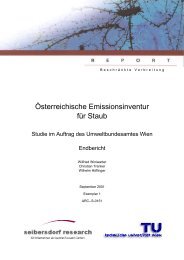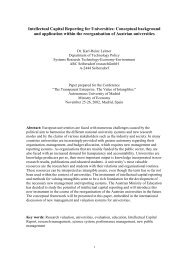ALPMON FINAL REPORT - ARC systems research
ALPMON FINAL REPORT - ARC systems research
ALPMON FINAL REPORT - ARC systems research
You also want an ePaper? Increase the reach of your titles
YUMPU automatically turns print PDFs into web optimized ePapers that Google loves.
Contract ENV4-CT96-0359 <strong>ALPMON</strong><br />
� the project- and variant specific database management<br />
� the fast input of external data (including data check) and<br />
� the optional data storage and restoration.<br />
In this module we have the interface to <strong>ALPMON</strong> caused by the need for grid-based data. The<br />
Bavarian State Office for Water Resources has the opinion, that the requirements can only be satisfied<br />
by using remote sensing data. These shall provide the basis for a detailed land use classification.<br />
The ASGI-project also includes the scaling aspects that exist in hydrological process grid modelling<br />
with GIS, with respect to selecting the optimal grid width.<br />
To fulfil the requirements of the customer a multi-temporal and a multi-seasonal remote sensing<br />
approach was planned:<br />
� a multi-seasonal approach to investigate the advantages and disadvantages of different times of<br />
taking satellite data within the summer period in the alpine region (e.g. shadow effects, phenological<br />
effects),<br />
� a multi-temporal approach for change detection purposes to demonstrate the possibilities of using<br />
satellite data for monitoring purposes.<br />
2.1.2.3 Austrian Institute for Avalanche and Torrent Research<br />
The Institute for Avalanche and Torrent Research is a subdivision of the Federal Ministry of Agriculture<br />
and Forestry, Federal Forest Research Center. Avalanche <strong>research</strong> is in charge of preparing improved<br />
guidelines for active and passive protection from avalanches, a function also important for the Austrian<br />
economy. The work includes the development of new control techniques, for example, forestry<br />
measures for the management of avalanche hazard zones and hazard zone planning. Avalanche<br />
documentation, including accident files, is an essential contribution to the improvement and<br />
standardisation of training and education programs.<br />
To identify potential hazard zones it is necessary to apply the criteria which have been derived from the<br />
measurement results, such as critical degree of crown closure, critical degree of gaps in the forest,<br />
etc., to larger areas. In order to adapt these criteria to regional variation, information is needed which<br />
covers all the variables which cause avalanches over extensive areas. Another requirement is that this<br />
information be available in digital form in a Geographical Information System in order to ensure that by<br />
means of automated processes the different information levels can be integrated and crossreferenced.<br />
So far, however, the kind of information that would fulfil the requirements outlined has not been<br />
available. While adequate data has been compiled for some areas, it is generally too heterogeneous to<br />
permit the integration of data into other databases. Moreover, the data only covers small areas and is<br />
thus not easily applied to the analyses of larger areas. The aim of <strong>ALPMON</strong> is therefore to compile<br />
standardised information for larger areas. High resolution remote sensing data permits the compilation<br />
of vegetation parameters from which surface roughness can be indirectly deduced. These parameters<br />
include forestry-related variables such as the distribution of different tree species, tree age, crown<br />
closure and gaps as well as alpine pastures, scree and rocks. The digital terrain model further makes<br />
available topographical parameters, such as slope, aspect and elevation.<br />
Two different types of avalanche risk models are currently developed at the Austrian Institute for<br />
Avalanche and Torrent Research:<br />
� Empirical models, which are based on the Austrian avalanche register (restricted to slab and gliding<br />
avalanches).<br />
� A fuzzy model based on actual laser measurements.<br />
All models need similar parameters from remote sensing and DEM sources. Among these, the actual<br />
information on land use/land cover can be derived from remote sensing data. Additionally, the<br />
topographic information (e.g. slope, aspect, inclination) can be computed using the digital elevation<br />
model (DEM).<br />
2.1.2.4 Centre for Avalanches and Hydrological Defence, Arabba<br />
The Avalanche and Hydrogeological Defence Experimental Centre of Arabba is a structure of the<br />
Veneto Regional Council, and is under the authority of the Department for Forests and Mountain<br />
Economy. The Avalanche Centre has developed, in the frame of the EROSLOPE project (No. EV5V-<br />
JR, RSDE, ALU, LMU, Seibersdorf, WSL 13




